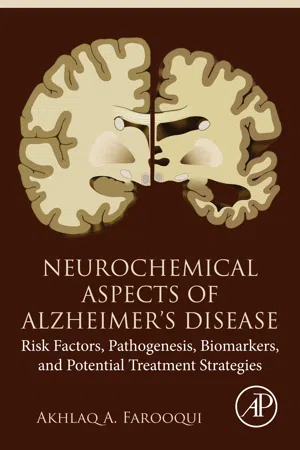Introduction
Alzheimer’s disease (AD), the most common form of dementia, is a complex disease characterized by the accumulation of extracellular β-amyloid (Aβ) plaques (senile plaques) and intracellular neurofibrillary tangles (NFTs) composed of Tau amyloid fibrils (Hardy, 2006, 2009) leading to the loss of synapses and degeneration of neurons in multiple brain regions (cortical and subcortical areas and hippocampus), causing a loss of cognitive brain functions, along with progressive impairment of activities of daily living and often behavioral and physiological changes like apathy and depression. How these factors ultimately contribute to memory impairments and cognitive deficits that clinically characterize the disease remains elusive. According to the 2010 World Alzheimer Report, there are an estimated 36 million people worldwide living with dementia at a total cost of more than US$600 billion in 2010, and the incidence of AD throughout the world is expected to double in the next 20 years (AD International, 2013). It is sixth leading cause of death in the United States victimizing about 5.5 million in the year 2012 (Alzheimer’s Association, 2012, 2013). By 2050, this number is expected to jump to 16 million, and in the next 20 years it is projected that AD will affect one in four Americans, rivaling the current prevalence of obesity and diabetes (Brookmeyer et al., 1998). At the neuropathological level the hallmarks of AD are the presence of senile plaques and tangles in brain. Major components of the Aβ deposits are hydrophobic Aβ peptides, which are 38- to 43-amino-acid-long fragments derived from proteolytic processing of the amyloid precursor protein (APP) (Aguzzi and Haass, 2003). Aβ forms aggregates, which accumulate in different subcellular organelles of neurons in patients with AD. Aβ plaques (senile plaques) first appear in the frontal cortex, and then spread over the entire cortical region, whereas hyperphosphorylated Tau and insoluble tangles initially appear in the limbic system (entorhinal cortex, hippocampus, and dentate gyrus) and then progress to the cortical region. Neurofibrillary tangles appear before the deposition of plaque in brains of patients with AD, and that tangle pathology is more closely associated with disease severity than the plaque load (Braak and Braak, 1998; Josephs et al., 2008). Other changes in AD include cerebral amyloid angiopathy (CAA), age-related brain atrophy, white matter rarefaction, and granulovacuolar degeneration. CAA is the most prevalent disturbance, appearing in about 70% of patients with AD along with agitation, which appears in about 50% of patients (Frisoni et al., 1999).
The majority of AD cases (>90%–95%) are sporadic [late-onset AD (LOAD)]. These patients are older than 65 years. Only 5%–7% cases are primarily genetic (early-onset familial form) involving apolipoprotein E (APOE), APP, presenilin 1 (PSEN 1), and presenilin 2 (PSEN 2) genes (Goate et al., 1991; van der Flier and Scheltens, 2005; Kowalska et al., 2004). All the aforementioned AD genes have been reported to upregulate the cerebral Aβ levels, with the majority of early-onset familial AD mutations increasing the ratio of Aβ42 to Aβ40, which enhances the oligomerization of Aβ into neurotoxic assemblies (Hardy and Selkoe, 2002). Among APOE genes, the APOE4 gene is the strongest and only confirmed genetic risk factor for the development of LOAD, which enhances the risk level by three times in heterozygous individuals and by 12 times in homozygous individuals (Bertram, 2009) compared to APOE3, whereas APOE2 decreases AD risk by approximately twofold per allele. Mechanism(s) by which APOE4 increases AD risk include both Aβ-dependent effects, i.e., modulation of Aβ levels, aggregation, neurotoxicity, and neuroinflammation, and Aβ-independent effects, i.e., neuronal development, glucose metabolism, brain activity, and lipid metabolism (Liu et al., 2013). APOE4 protein not only regulates Aβ aggregation and clearance but also is an essential regulator of brain cholesterol metabolism. APOE4 plays an important role in cerebral energy metabolism, modulation of chronic inflammation, neurovascular function, neurogenesis, and synaptic plasticity (Kim et al., 2009, 2014). Sporadic AD is not only accompanied by an accumulation of Aβ plaques and neurofibrillary tangles (Hardy, 2006, 2009), but also by many metabolic, pathological, and neurochemical alterations, including hypometabolism (Mosconi et al., 2008), disruption of blood–brain barrier (BBB) (Zlokovic, 2011), alterations in lipid and glucose metabolism, onset of diabetes and metabolic syndrome, activation of microglial and astroglial cells, and onset of oxidative stress (Mrak and Griffin, 2005; Prokop et al., 2013; Farooqui, 2013, 2014). Among these factors, oxidative stress occurs at early stages of AD before the appearance of amyloid plaques and neurofibrillary tangles and acts to exacerbate the disease progression. Many hypotheses have been proposed to explain the neurodegeneration in AD including: (1) selective vulnerability of cholinergic neurons in the basal forebrain, (2) aluminum deposit hypothesis, (3) Aβ cascade hypothesis, (4) reduction in neurotrophic factors, (5) protein misfolding and aggregation hypothesis, (6) amyloid cascade inflammatory hypothesis, (7) neurovascular hypothesis, (8) insulin insensitivity hypothesis, and (9) dendritic hypothesis (Katzman and Saitoh, 1991; Castellani et al., 2009; Karran et al., 2011; McGeer and McGeer, 2013; Farooqui, 2013; Zlokovic, 2011; de la Monte and Tong, 2014; Cochran et al., 2014). Among the aforementioned hypotheses, two major hypotheses are the cholinergic hypothesis, which ascribes the clinical features of dementia to the deficit cholinergic neurotransmission, and the amyloid cascade hypothesis, which emphasizes the deposition of insoluble peptides formed due to the faulty cleavage of the APP. Although Aβ cascade hypothesis does not explain all features of AD, it has dominated research studies on AD from the past 20 years. This hypothesis was proposed in the late 1980s (Allsop et al., 1988; Selkoe, 1989) and was formalized in 1992 in a review by Hardy...
